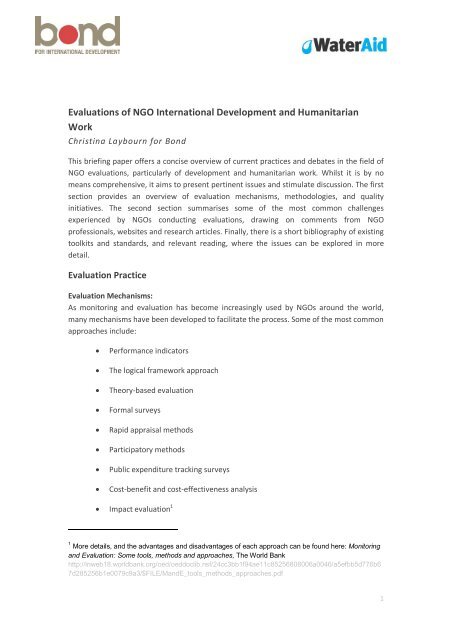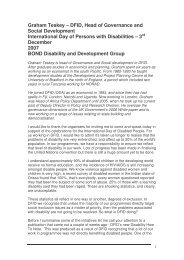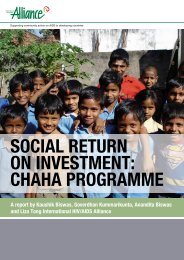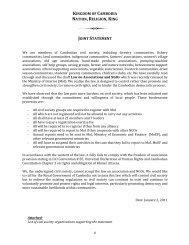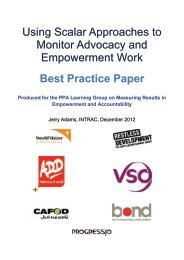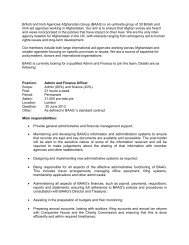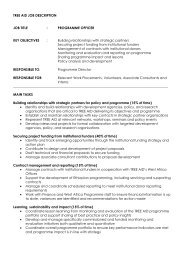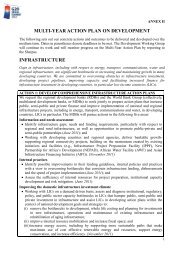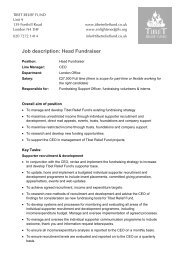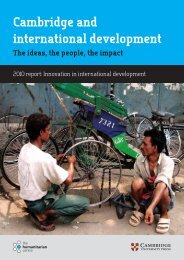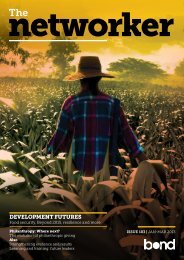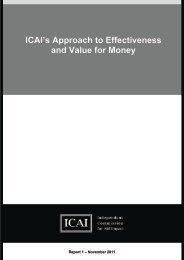Evaluations of NGO International Development and ... - Bond
Evaluations of NGO International Development and ... - Bond
Evaluations of NGO International Development and ... - Bond
- No tags were found...
You also want an ePaper? Increase the reach of your titles
YUMPU automatically turns print PDFs into web optimized ePapers that Google loves.
<strong>Evaluations</strong> <strong>of</strong> <strong>NGO</strong> <strong>International</strong> <strong>Development</strong> <strong>and</strong> HumanitarianWorkChristina Laybourn for <strong>Bond</strong>This briefing paper <strong>of</strong>fers a concise overview <strong>of</strong> current practices <strong>and</strong> debates in the field <strong>of</strong><strong>NGO</strong> evaluations, particularly <strong>of</strong> development <strong>and</strong> humanitarian work. Whilst it is by nomeans comprehensive, it aims to present pertinent issues <strong>and</strong> stimulate discussion. The firstsection provides an overview <strong>of</strong> evaluation mechanisms, methodologies, <strong>and</strong> qualityinitiatives. The second section summarises some <strong>of</strong> the most common challengesexperienced by <strong>NGO</strong>s conducting evaluations, drawing on comments from <strong>NGO</strong>pr<strong>of</strong>essionals, websites <strong>and</strong> research articles. Finally, there is a short bibliography <strong>of</strong> existingtoolkits <strong>and</strong> st<strong>and</strong>ards, <strong>and</strong> relevant reading, where the issues can be explored in moredetail.Evaluation PracticeEvaluation Mechanisms:As monitoring <strong>and</strong> evaluation has become increasingly used by <strong>NGO</strong>s around the world,many mechanisms have been developed to facilitate the process. Some <strong>of</strong> the most commonapproaches include:Performance indicatorsThe logical framework approachTheory‐based evaluationFormal surveysRapid appraisal methodsParticipatory methodsPublic expenditure tracking surveysCost‐benefit <strong>and</strong> cost‐effectiveness analysis Impact evaluation 11 More details, <strong>and</strong> the advantages <strong>and</strong> disadvantages <strong>of</strong> each approach can be found here: Monitoring<strong>and</strong> Evaluation: Some tools, methods <strong>and</strong> approaches, The World Bankhttp://lnweb18.worldbank.org/oed/oeddoclib.nsf/24cc3bb1f94ae11c85256808006a0046/a5efbb5d776b67d285256b1e0079c9a3/$FILE/M<strong>and</strong>E_tools_methods_approaches.pdf1
There are now a wide‐range <strong>of</strong> training workshops <strong>and</strong> toolkits to help <strong>NGO</strong>s implementthese M&E strategies, however, evidence suggests that implementing an effective M&Esystem takes considerable time <strong>and</strong> support 2 . As will be discussed later, there are stillconsiderable challenges to <strong>NGO</strong> evaluations, however some <strong>NGO</strong>s have developed internalevaluation st<strong>and</strong>ards to ensure that their assessments are <strong>of</strong> a high quality. For example,Oxfam GB has developed Programme Evaluation St<strong>and</strong>ards which outline Oxfam’s policy onhow to conduct programme evaluations, <strong>and</strong> how to respond to <strong>and</strong> share evaluationfindings 3 .Evaluation MethodologiesSelf‐assessmentAs confidence <strong>and</strong> training in M&E methods grows, <strong>NGO</strong>s are increasingly choosing toconduct evaluations <strong>of</strong> their work themselves 4 : asking staff to assess programmes orprojects, <strong>and</strong> submit reports to senior management. Self‐assessment has the considerableadvantage <strong>of</strong> being cheaper to implement than hiring an independent consultant. It also canencourage learning, <strong>and</strong> a sense <strong>of</strong> ownership <strong>of</strong> the evaluation process amongst staff.Agency staff may also be better placed to underst<strong>and</strong> the complexities <strong>of</strong> a project orprogramme than an external evaluator.However, <strong>NGO</strong>s can find that self‐assessments can be difficult to conduct effectively, <strong>and</strong>internal evaluators may miss some things that an outside observer would pick up on. Theyalso lack a guarantee <strong>of</strong> impartiality. For these reasons self‐assessments can have lesscredibility.Peer‐assessment (also know as joint evaluation)Peer‐assessment involves staff from one or more peer organisation conducting theevaluation. This means that, again, costs are kept relatively low, however evaluations bypeople external to the organisation can be more insightful, <strong>and</strong> more credible. Because theassessors come from similar organisations, they will be well informed about the challenges<strong>of</strong> the sector.The principle difficulty with peer assessment is that it requires a high level <strong>of</strong> trust between<strong>NGO</strong>s, so that the assessed organisation can be open <strong>and</strong> honest during the evaluation.Where there is strong competition for funds, for example, <strong>NGO</strong>s may be unwilling to let a2 Jean Ellis, Accountability <strong>and</strong> Learning: developing monitoring <strong>and</strong> evaluation in the third sector, CES(2008) http://www.ces-vol.org.uk/index.cfm?format=4883 Oxfam GB Programme Evaluation Policy http://oxfam.intellidirect.com/e/d.dll?m=234&url=http://www.oxfam.org.uk/resources/evaluations/downloads/oxfam_evaluation_policy.pdf4 Monitoring <strong>and</strong> Evaluation in the Third Sector: Survey Findings Charities Evaluation Services (2007)p2 http://www.ces-vol.org.uk/index.cfm?format=1512
potential rival organisation scrutinise their operations, in case the information is later usedagainst them.Large <strong>NGO</strong>s sometimes opt for an approach halfway between the two above: sending stafffrom one country <strong>of</strong>fice to evaluate the work <strong>of</strong> another <strong>of</strong>fice. This combines both thebenefits <strong>of</strong> familiarity with the organisations systems, <strong>and</strong> the insight <strong>of</strong> an outsideperspective.Peer‐reviewA slightly different approach is where an <strong>NGO</strong> submits their self‐assessment to a peerorganisation for review, or where a peer conducts an assessment <strong>of</strong> an <strong>NGO</strong>’s evaluationsystem. As will be discussed later, this is an effective way <strong>of</strong> maintaining evaluationst<strong>and</strong>ards, but does not actually involve the peer assessing the <strong>NGO</strong>’s work.External‐assessmentAn <strong>NGO</strong> may commission an independent consultant to conduct an assessment <strong>of</strong> some orall <strong>of</strong> its work. Although external‐assessment is increasingly giving way to self‐assessment, itis still <strong>of</strong>ten required by donors when large amounts <strong>of</strong> funding have been awarded.External‐assessments have more credibility, <strong>and</strong>, as with peer assessments, an outsideperspective can <strong>of</strong>fer some useful insights <strong>and</strong> suggestions, that the organisation’s staff maynot have thought <strong>of</strong>.However, external assessments can be very costly: where the overall programme budget issmall to begin with, hiring an independent consultant may simply not be feasible.Quality AssuranceAs will be discussed later, one <strong>of</strong> the primary difficulties cited with <strong>NGO</strong> evaluations is theirvariable quality. Where evaluations lack reliable detail or analysis, their findings will not becredible or useful. Several quality assurance initiatives have been developed in an attempt toaddress this, although they are primarily intended for donor bodies, rather than <strong>NGO</strong>sthemselves.The OECD <strong>Development</strong> Assistance Committee (DAC) has produced a set <strong>of</strong> Principles forevaluating development assistance, intended for donor governments <strong>and</strong> multi‐lateralorganisations. First published in 1991, the Principles include impartiality, independence,credibility <strong>and</strong> usefulness. These Principles are now widely adopted by developmentagencies in DAC member countries, <strong>and</strong> by several multilateral/international financialinstitutions, such as UNDP, the World Bank, <strong>and</strong> the IMF. Members <strong>of</strong> the DAC conduct jointevaluations <strong>of</strong> peer members against the Principles. DAC has also recently published a set <strong>of</strong>Quality St<strong>and</strong>ards for <strong>Development</strong> Evaluation, which are intended to provide a guide togood evaluation practice. The St<strong>and</strong>ards follow the structure <strong>of</strong> a typical evaluation process:defining purpose, planning, implementing, reporting, <strong>and</strong> learning from evaluation results.Although the DAC Principles <strong>and</strong> St<strong>and</strong>ards are intended for DAC members, they can beadopted by other development partners. For example, the Humanitarian network ALNAP has3
adapted the DAC Principles for conducting evaluations in complex emergencies, into a guidefor Humanitarian agencies. DFID’s guidance notes for <strong>NGO</strong> evaluations also draw on the DACSt<strong>and</strong>ards.The UN Evaluation Group has also developed extensive guidance for conducting evaluations,including St<strong>and</strong>ards, a Code <strong>of</strong> Conduct, Norms <strong>and</strong> Ethical Guidelines. All UN departmentsnow conduct evaluations according to these st<strong>and</strong>ards, meaning that evaluations fromdifferent departments can be collated <strong>and</strong> presented collectively to donors.Several donor agencies have systems in place to ensure the quality <strong>of</strong> their own evaluations,or those <strong>of</strong> their funded <strong>NGO</strong>s. For example, the Swedish development agency, Sida,commissioned an independent assessment <strong>of</strong> Sida evaluations in 2008, which assessed theircoverage, credibility <strong>and</strong> usefulness <strong>of</strong> the results information. The report found severalareas <strong>of</strong> weakness, <strong>and</strong> recommended improvements to Sida’s evaluation processes 5 .The Dutch Ministry <strong>of</strong> Foreign Affairs’ Evaluation Department (IOB) similarly conducted anassessment <strong>of</strong> the Ministry’s new Tailor‐made Monitoring system for <strong>NGO</strong>s, to assess itsbenefits <strong>and</strong> disadvantages 6 . The Dutch Ministry also asks <strong>NGO</strong>s in receipt <strong>of</strong> the largestgrants to submit their self‐evaluations to the IOB so that the quality <strong>of</strong> the evaluations canbe assessed.ALNAP has made notable efforts to monitor <strong>and</strong> improve the quality <strong>of</strong> evaluations byHumanitarian <strong>NGO</strong>s, beyond adapting the DAC Principles, as mentioned above. Between2001 <strong>and</strong> 2006 ALNAP conducted yearly “meta‐evaluations” <strong>of</strong> <strong>Evaluations</strong> <strong>of</strong> HumanitarianAid (EHA), using a Quality Pro Forma that they developed according to accepted evaluationgood practice. Details <strong>of</strong> the “meta‐evaluations” were published in ALNAP’s yearly Review <strong>of</strong>Humanitarian Action. This autumn, ALNAP has begun a process <strong>of</strong> action research focusingon strengthening the evaluation capacities <strong>of</strong> humanitarian organisations, <strong>and</strong> has produceda draft paper <strong>and</strong> framework <strong>of</strong> how to improve the effectiveness <strong>and</strong> use <strong>of</strong> humanitarianevaluations 7 .5 Kim Forss, Evert Vedung, Stein-Erik Kruse, Agnes Mwaiselage, Anna Nilsdotter Are Sida <strong>Evaluations</strong>Good Enough? An Assessment <strong>of</strong> 34 Evaluation Reports Sida (2008)http://sidapublications.citat.se/interface/frmoptimaker3.asp?doctype=3&order=createdateDESC&departmentid=298&topheight=55&headerheight=23&fotheight=0&leftframewidth=300&width=820&stylesheet=sida.css&frameout=0&language=14&login=True&username=sih6 ‘Maatgesneden monitoring, beperkte beleidsdoorlichting MFS’ (A Limited Policy review <strong>of</strong> MFS TailormadeMonitoring) (2009)http://www.minbuza.nl/nl/Organisatie/Evaluatie/Afgeronde_onderzoeken/2009/04/IOB_Maatgesneden_monitoring_beperkte_beleidsdoorlichting_MFS7 Alistair Hallam Strengthening organisational capacities for evaluation <strong>of</strong> humanitarian action (Draft)ALNAP (2010) http://www.alnap.org/pool/files/org-capacities-workshop.pdf4
Accountability <strong>and</strong> Learning ParadoxAnother <strong>of</strong> the common problems cited, is the sometimes contradictory purpose <strong>of</strong>conducting an evaluation. <strong>Evaluations</strong> are intended to highlight both the successes <strong>and</strong>challenges experienced during a programme <strong>of</strong> work. However, evaluations are also <strong>of</strong>tencommissioned at the request <strong>of</strong> donors. <strong>NGO</strong> pr<strong>of</strong>essionals see this as creating dual pullbetween learning from mistakes, <strong>and</strong> accounting to your donor 14 . If future funding is in anyway influenced by the <strong>NGO</strong>’s previous achievements, there are clear incentives to emphasisesuccesses, <strong>and</strong> minimise failures. However, by not reporting or examining any challenges,valuable learning opportunities are missed, both by the subject <strong>NGO</strong>, <strong>and</strong> by others whoread the evaluation.Use <strong>of</strong> <strong>Evaluations</strong>The ALNAP report on the utilisation <strong>of</strong> evaluations, notes concern in the sector thatevaluation results will not be used 15 . Jonthanan Patrick, Evaluation Adviser at DFID,recognises this concern amongst <strong>NGO</strong>s that evaluations will “fall into a black hole” once theyare submitted to a donor agency 16 . The sense that submitting evaluations to donors ismerely a “check box” exercise, <strong>and</strong> that they are not properly read, may contribute to thevarying st<strong>and</strong>ards by which evaluations are conducted. Donor agencies such as DFID <strong>and</strong> theDutch Ministry <strong>of</strong> Foreign Affairs admit that they cannot yet adequately process <strong>and</strong> collateall the findings from evaluations that are submitted to them 17 . However, there are someefforts to collate findings from evaluations: the Norwegian development agency NORAD hascommissioned synthesis reports <strong>of</strong> evaluations <strong>of</strong> Humanitarian assistance, <strong>and</strong>Environmental <strong>Development</strong> assistance 18 .Learning from <strong>Evaluations</strong>One <strong>of</strong> the most concerning issues around evaluations <strong>of</strong> <strong>NGO</strong> work, is that the findings arenot shared, <strong>and</strong> recommendations are not implemented. Although evaluations are widelyperceived to function as a tool for learning, an ALNAP report found very little evidence thatevaluations are used by <strong>NGO</strong>s to bring about changes or improvements in operations 19 . Anevaluation <strong>of</strong> the quality <strong>of</strong> DFID’s evaluation reports <strong>and</strong> assurance systems similarly noted14 Summary Report: European M&E Workshop INTRAC 2005; p 8; Harry Derksen, ICCO, privateconversation 12/08/201015 Peta S<strong>and</strong>ison, ‘The Utilisation <strong>of</strong> <strong>Evaluations</strong>’ in ALNAP Review <strong>of</strong> Humanitarian Action 2005,ALNAP (2005) p9016 Jonathan Patrick, private conversation 26/10/1017 Jonathan Patrick, private conversation 26/10/10; Phil Compernolle, Evaluator, Policy <strong>and</strong> OperationsEvaluation Department, Dutch Ministry <strong>of</strong> Foreign Affairs, private conversation 03/09/1018 Humanitarian Response to Natural Disasters: A Synthesis <strong>of</strong> Evaluation Findings, NORAD (2009); ASynthesis <strong>of</strong> <strong>Evaluations</strong> <strong>of</strong> Environmental <strong>Development</strong> Assistance by Multilateral Organisations,NORAD (2009).19 ALNAP (2005)6


